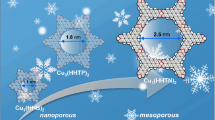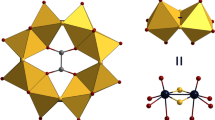Abstract
A series of heterotrimetallic dysprosium–manganese–sodium 12-metallacrown-4 compounds has been synthesized and characterized by single-crystal X-ray analysis: DyNaX4[12-MCMn(III)N(shi)-4], where X− = 2-fluorobenzoate (1), 3-fluorobenzoate (2), 4-fluorobenzoate (3), 2-chlorobenzoate (4), 4-chlorobenzoate (5), 3-bromobenzoate (6), and 2-iodobenzoate (7); MC is metallacrown; and shi3− is salicylhydroximate. Each 12-MC-4 framework is comprised of four ring MnIII ions and four shi3− ligands. The oxime oxygen atoms of the shi3− ligands produce a central cavity which then binds one DyIII ion and one Na+ ion on opposite sides. In each molecule four halogenated benzoate anions bridge between the central DyIII ion and the ring MnIII ions via the carboxylate groups. The identity of the halogenated benzoate anion has little effect on the structure of the [12-MCMn(III)N(shi)-4] framework as determined by several metrical parameters: the MC cavity radius, the average cross cavity MnIII–MnIII distance, the average cross cavity oxime oxygen-oxime oxygen distance, and the distance of the DyIII from the oxime oxygen mean plane. For 1–7 these metrical parameters are strikingly similar; thus, providing further reinforcement of one hallmark of metallacrown chemistry—the ability to substitute various components of the molecule without affecting the overall structure which can be used for the fine-tuning of molecular properties.
Graphic Abstract
Four 4-fluorobenzoate (4-Fben) anions bridge between the central DyIII ion and the ring MnIII ions in the metallacrown compound DyNa(4-Fben)4[12-MCMn(III)N(shi)-4](H2O)4·4DMF.









Similar content being viewed by others
Availability of Data and Materials
CCDC 2032652-2032658 contain the supplementary crystallographic data for this paper. These data can be obtained free of charge from The Cambridge Crystallographic Data Centre via https://www.ccdc.cam.ac.uk/structures/.
References
Han H, Wei Z, Filatov AS, Carozza JC, Alkan M, Rogachev AY, Shevtsov A, Abakumov AM, Pak C, Shatruk M, Chen Y-S, Dikarev EV (2019) Three to tango requires a site-specific substitution: heterotrimetallic molecular precursors for high-voltage rechargeable batteries. Chem Sci 10:524–534
Andruh M (2018) Hetereotrimetallic complexes in molecular magnetism. Chem Commun 54:3559–3577
Chang X-Y, Xu G-T, Cao B, Wang J-Y, Huang J-S, Che C-M (2017) Assembly of strongly phosphorescent hetero-bimetallic and trimetallic [2]catenane structures based on a coinage metal alkynyl system. Chem Sci 8:7815–7820
Kuwamura N, Kurioka Y, Konno T (2017) A platinum(II)-palladium(II)-nickel(II) heterotrimetallic coordination polymer showing a cooperative effect on catalytic hydrogen evolution. Chem Commun 53:846–849
Cook TR, Stang PJ (2015) Recent developments in the preparation and chemistry of metallacycles and metallacages via coordination. Chem Rev 115:7001–7045
Mezei G, Zaleski CM, Pecoraro VL (2007) Structural and functional evolution of metallacrowns. Chem Rev 107:4933–5003
Lah MS, Pecoraro VL (1991) A functional analogy between crown ethers and metallacrowns. Inorg Chem 30:878–880
Azar MR, Boron TT III, Lutter JC, Daly CI, Zegalia KA, Nimthong R, Ferrence GM, Zeller M, Kampf JW, Pecoraro VL, Zaleski CM (2014) Controllable formation of heterotrimetallic coordination compounds—systematically incorporating lanthanide and alkali metal ions into the manganese 12-metallacrown-4 framework. Inorg Chem 53:1729–1742
Chow CY, Eliseeva SV, Trivedi ER, Nguyen TN, Kampf JW, Petoud S, Pecoraro VL (2016) Ga3+/Ln3+ metallacrowns: a promising family of highly luminescent lanthanide complexes that covers visible and near-infrared domains. J Am Chem Soc 138:5100–5109
Travis JR, Smihosky AM, Kauffman AC, Ramstrom SE, Lewis AJ, Nagy SG, Rheam RE, Zeller M, Zaleski CM (2020) Syntheses and crystal structures of two classes of aluminum-lanthanide-sodium heterotrimetallic 12-metallacrown-4 compounds: individual molecules and dimers of metallacrowns. J Chem Crystallogr. https://doi.org/10.1007/s10870-020-00861-2
Travis JR, Zeller M, Zaleski CM (2015) Crystal structure of tetraaqua(dimethylformamide) tetrakis(μ-N,2-dioxidobenzene-1-carboximidato)tetrakis(μ-trimethylacetato)tetramanganese(III)sodiumyttrium–dimethylformamide–water (1/8.04/0.62). Acta Cryst E 71:1300–1306
Travis JR, Zeller M, Zaleski CM (2016) Facile carboxylate ligand variation of heterotrimetallic 12-metallacrown-4 complexes. Polyhedron 114:29–36
Boron TT III, Lutter JC, Daly CI, Chow CY, Davis AH, Nimthong-Roldán A, Zeller M, Kampf JW, Zaleski CM, Pecoraro VL (2016) The nature of the bridging anion controls the single-molecule magnetic properties of DyX4M 12-metallacrown-4 complexes. Inorg Chem 55:10597–10607
Manickas EC, Zeller M, Zaleski CM (2020) Crystal structure of two heterotrimetallic dysprosium-manganese-sodium 12-metallacrown-4 complexes with the bridging ligands 3-hydroxybenzoate and 4-hydroxybenzoate. Acta Cryst E 76:1213–1221
Bruker Apex3 and SAINT. Bruker AXS Inc., Madison, WI
Krause L, Herbst-Irmer R, Sheldrick GM, Stalke D (2015) Comparison of silver and molybdenum microfocus X-ray sources for single-crystal structure determination. J Appl Cryst 48:3–10
Sheldrick GM (2012) TWINABS. University of Göttingen, Germany
SHELXTL suite of programs, Version 6.14, 2000–2003, Bruker advanced X-ray solutions, Bruker AXS Inc., Madison, Wisconsin, USA
Sheldrick GM (2008) A Short History of SHELX. Acta Cryst A 64:112–122
Sheldrick GM (2018) SHELXL2018. University of Göttingen, Germany
Sheldrick GM (2015) Crystal structure refinement with SHELXL. Acta Cryst C 71:3–8
Hübschle CB, Sheldrick GM, Dittrich B (2011) ShelXle: a Qt graphical user interface for SHELXL. J Appl Cryst 44:1281–1284
van der Sluis P, Spek AL (1990) BYPASS: an effective method for the refinement of crystal structures containing disordered solvent regions. Acta Cryst A 46:194–201
Spek AL (2015) PLATON SQUEEZE: a tool for the calculation of the disordered solvent contribution to the calculated structure factors. Acta Cryst C 71:9–18
Liu W, Thorp HH (1993) Bond valence sum analysis of metal-ligand bond lengths in metalloenzymes and model complexes. 2. Refined distances and other enzymes. Inorg Chem 32:4102–4105
Trzesowska A, Kruszynski R, Bartczak TJ (2004) New bond-valence parameters for lanthanides. Acta Cryst B 60:174–178
Alvarez S, Avnir D, Llunell M, Pinksy M (2002) Continuous symmetry maps and shape classification. The case of six-coordinated metal compounds. New J Chem 26:996–1009
Llunell M, Casanova D, Cirera J, Alemany P, Alvarez S (2013) SHAPE, version 2.1. Barcelona, Spain
Pinksy M, Avnir D (1998) Continuous symmetry measures. 5. The classical polyhedra. Inorg Chem 37:5575–5582
Casanova D, Cirera J, Llunell M, Alemany P, Avnir D, Alvarez S (2004) Minimal distortion pathways in polyhedral rearrangements. J Am Chem Soc 126:1755–1763
Cirera J, Ruiz E, Alvarez S (2005) Continuous shape measures as a stereochemical tool in organometallic chemistry. Organometallics 24:1556–1562
Casanova D, Llunell M, Alemany P, Alvarez S (2005) The rich stereochemistry of eight-vertex polyhedra: a continuous shape measures study. Chem Eur J 11:1479–1494
Ruiz-Martínez A, Casanova D, Alvarez S (2008) Polyhedral structure with an odd number of vertices: nine-atom clusters and supramolecular architectures. Dalton Trans 2583–2591
Macrae CF, Edgington PR, McCabe P, Pidcock E, Shields GP, Taylor R, Towler M, van de Streek J (2006) Mercury: visualization and analysis of crystal structures. J Appl Crystallogr 39:453–457
Haynes WM (2010) CRC handbook of chemistry and physics, 91st edn. CRC Press, Boca Raton, FL, pp 8–42–8–51
Funding
This work was funded by the Shippensburg University College of Arts & Sciences Faculty-Led Research Fund to CMZ. The Bruker AXS D8 Quest CMOS X-ray diffractometers were funded by the National Science Foundation through the Major Research Instrumentation Program under Grants No. CHE 1625543 to MZ.
Author information
Authors and Affiliations
Contributions
All authors contributed to the study conception and design. Material preparation, data collection and analysis were performed by CHM, MZ, and CMZ. The first draft of the manuscript was written by CMZ and all authors commented on previous versions of the manuscript. All authors read and approved the final manuscript.
Corresponding author
Ethics declarations
Conflict of interest
The authors declare that they have no conflict of interest.
Additional information
Publisher's Note
Springer Nature remains neutral with regard to jurisdictional claims in published maps and institutional affiliations.
Rights and permissions
About this article
Cite this article
Michael, C.H., Zeller, M. & Zaleski, C.M. Syntheses and Crystal Structures of a Series of Dysprosium–Manganese–Sodium 12-Metallacrown-4 Compounds with Halogenated Benzoate Bridging Anions. J Chem Crystallogr 51, 562–574 (2021). https://doi.org/10.1007/s10870-021-00880-7
Received:
Accepted:
Published:
Issue Date:
DOI: https://doi.org/10.1007/s10870-021-00880-7




